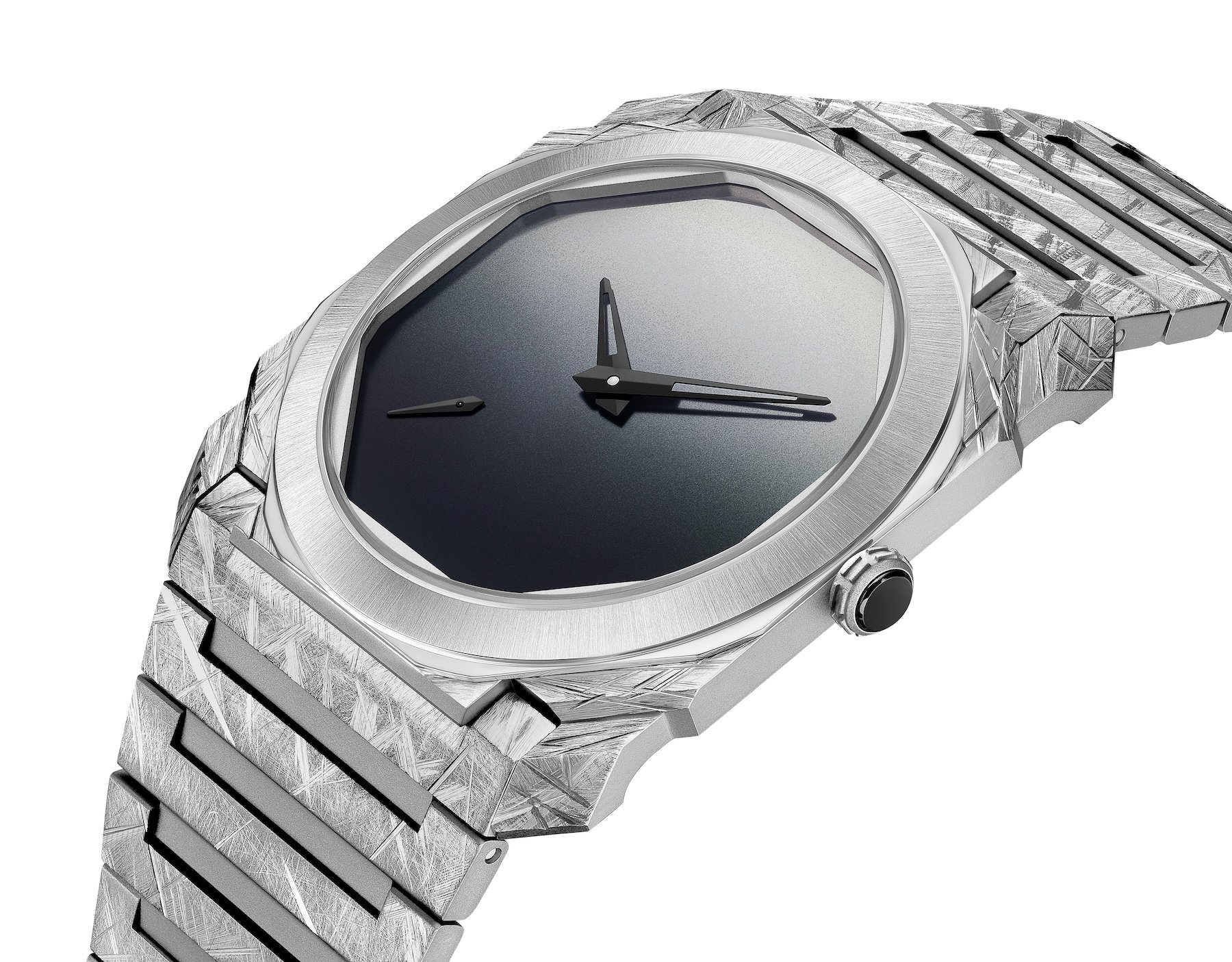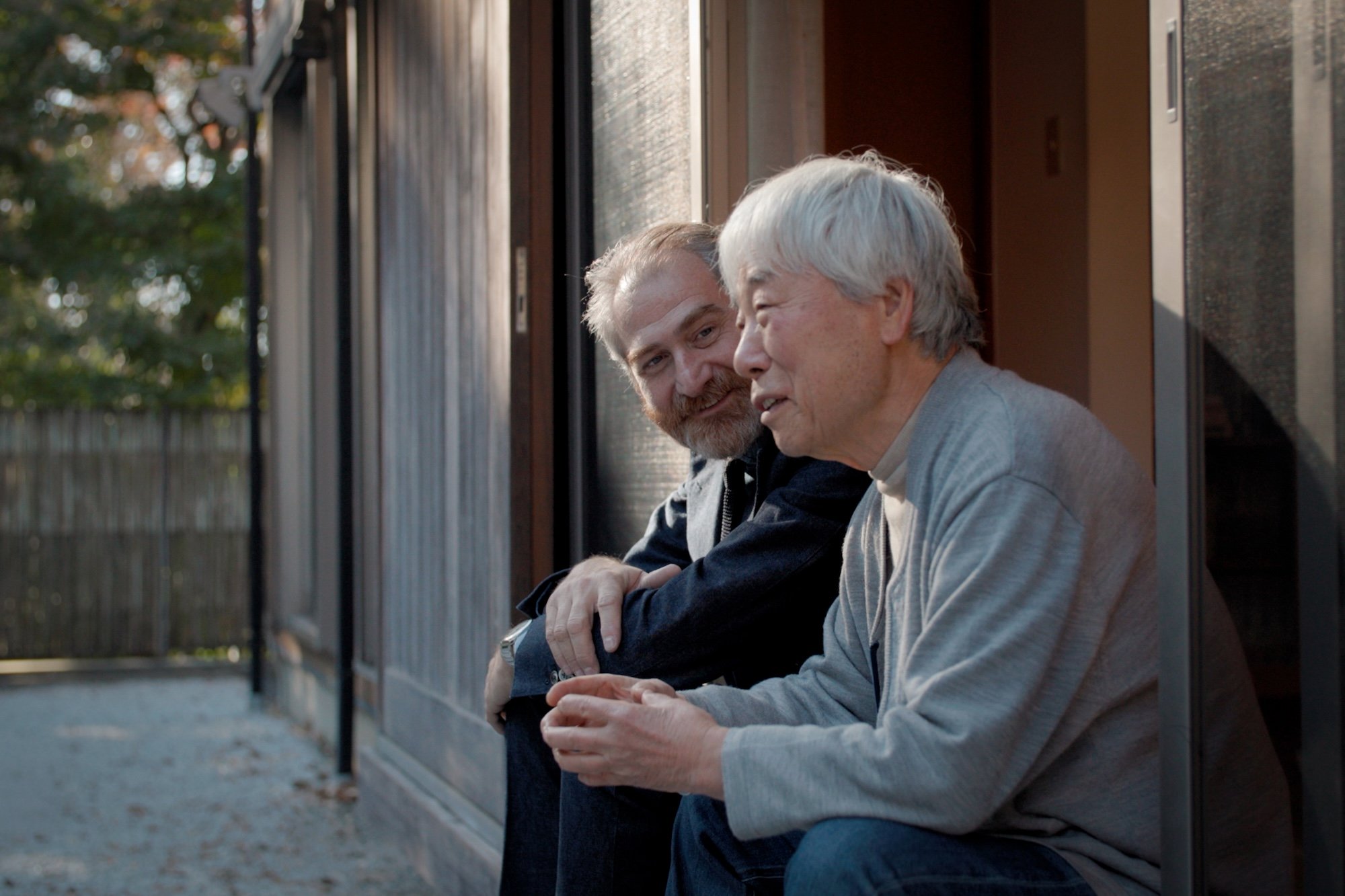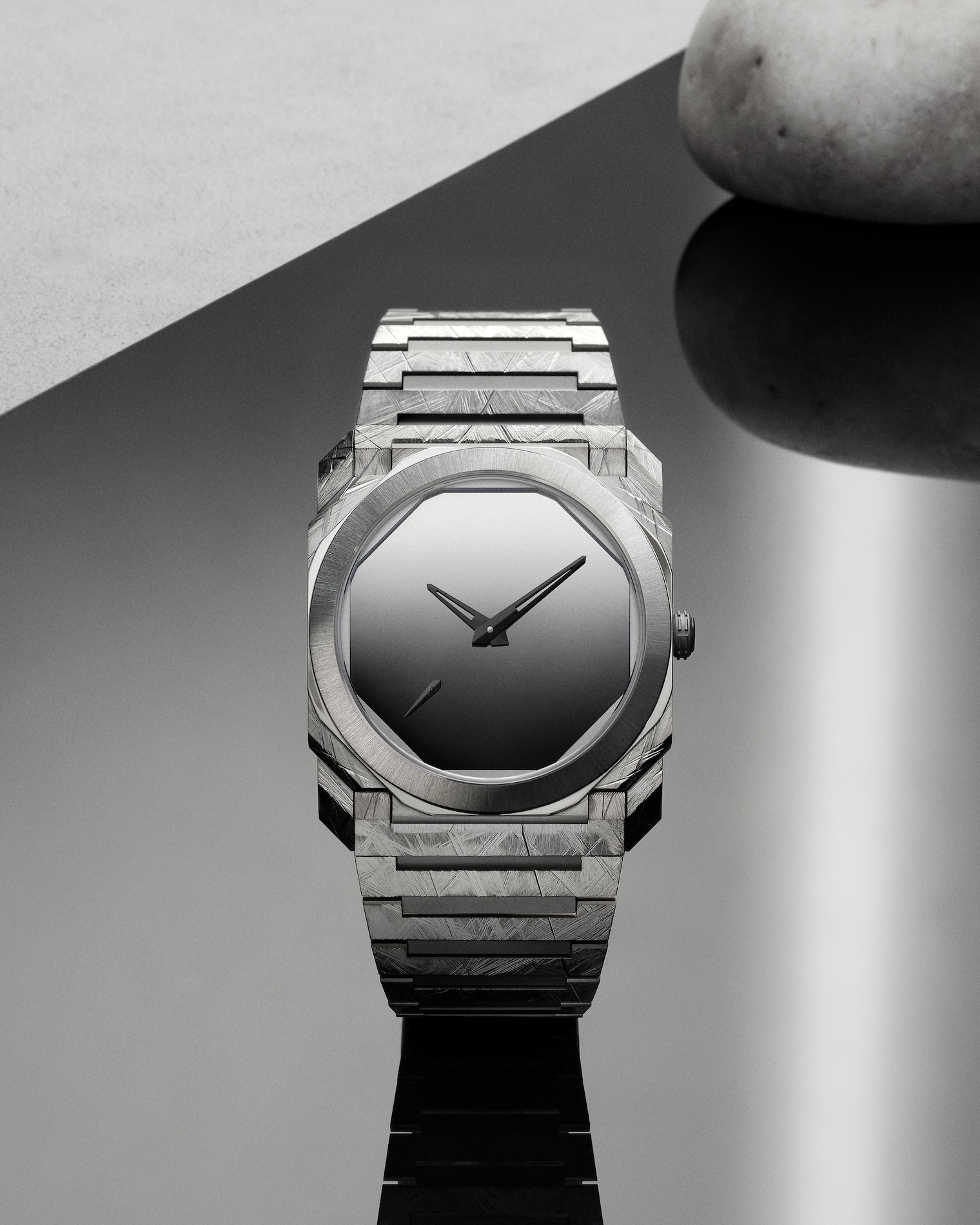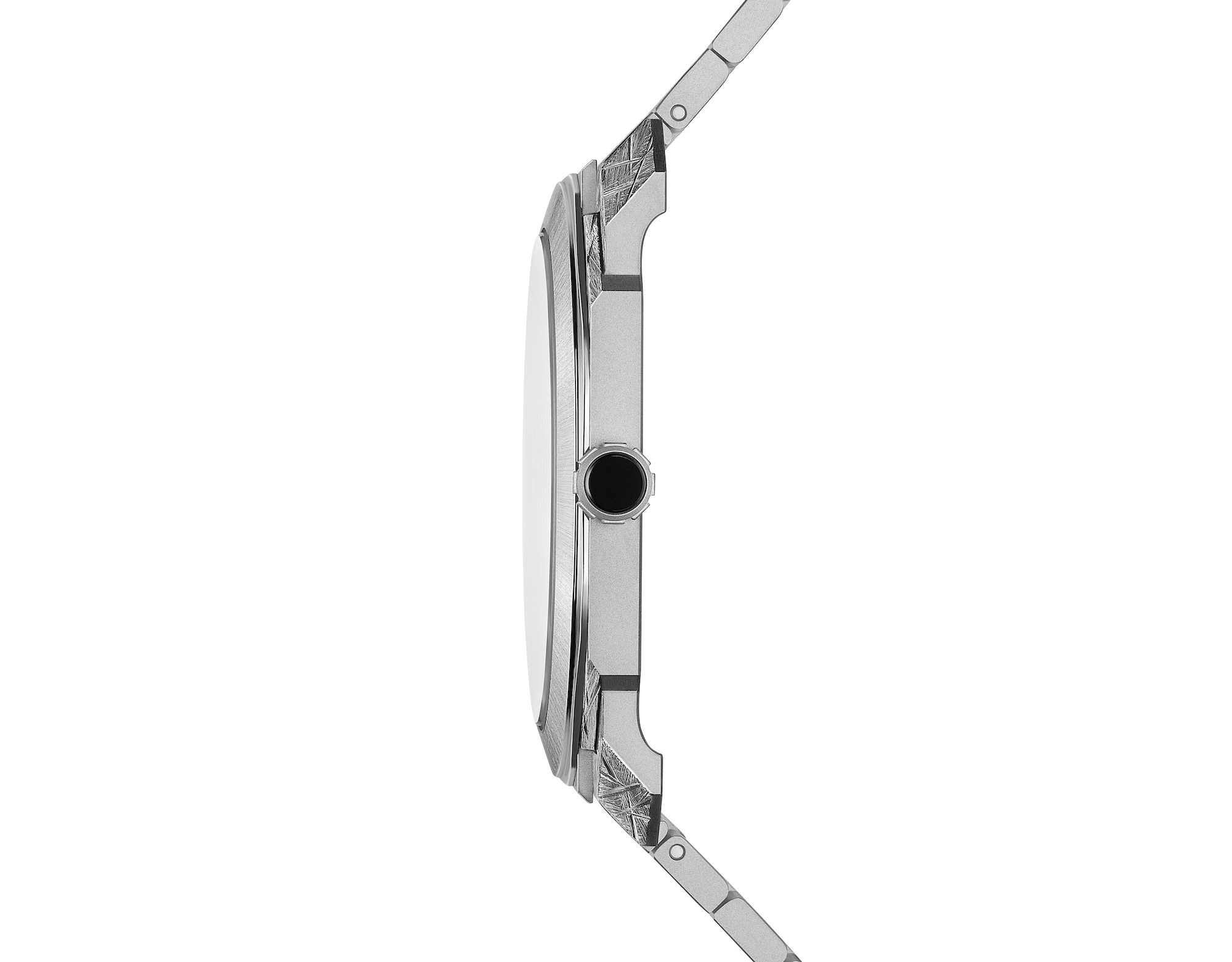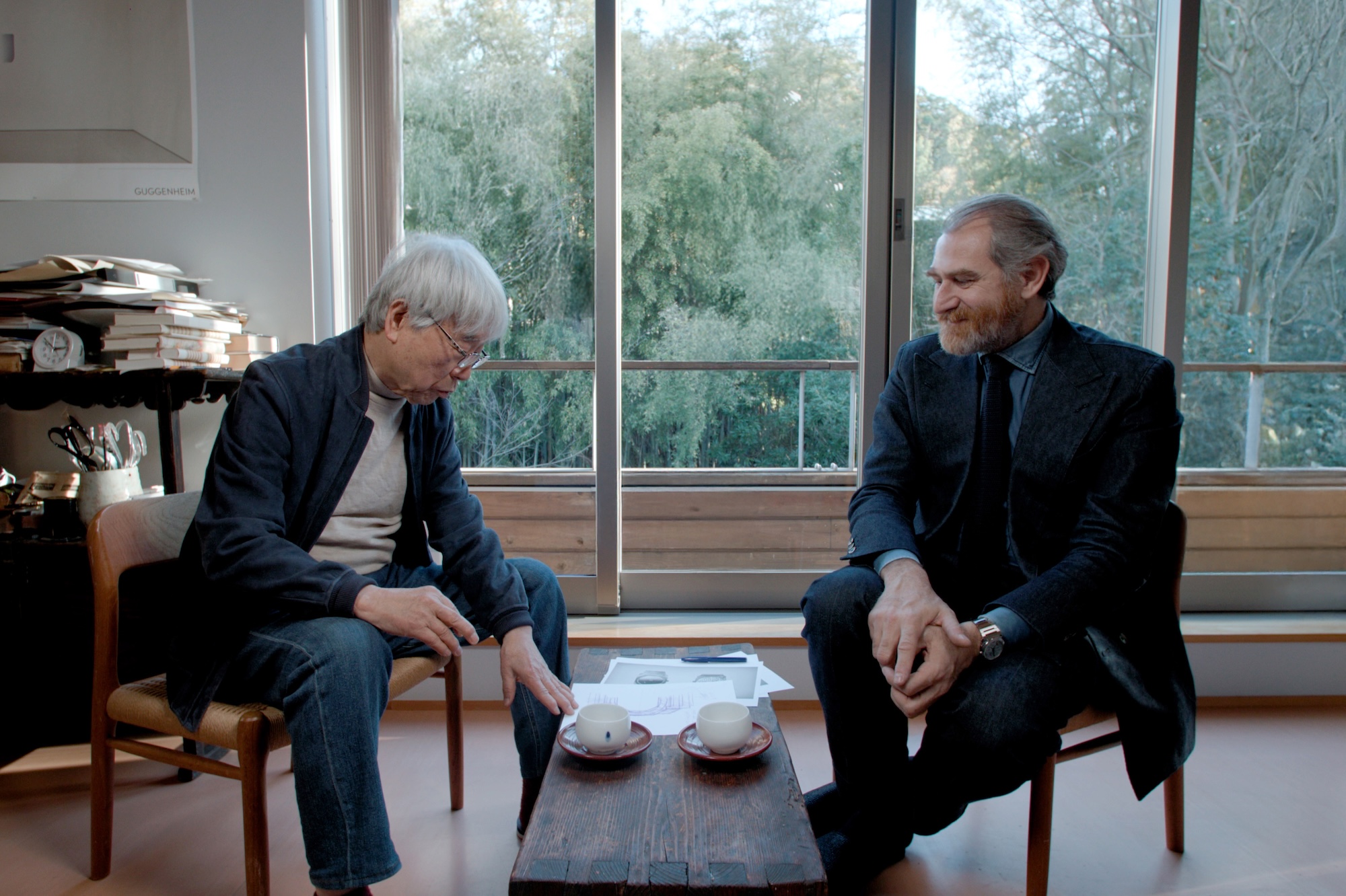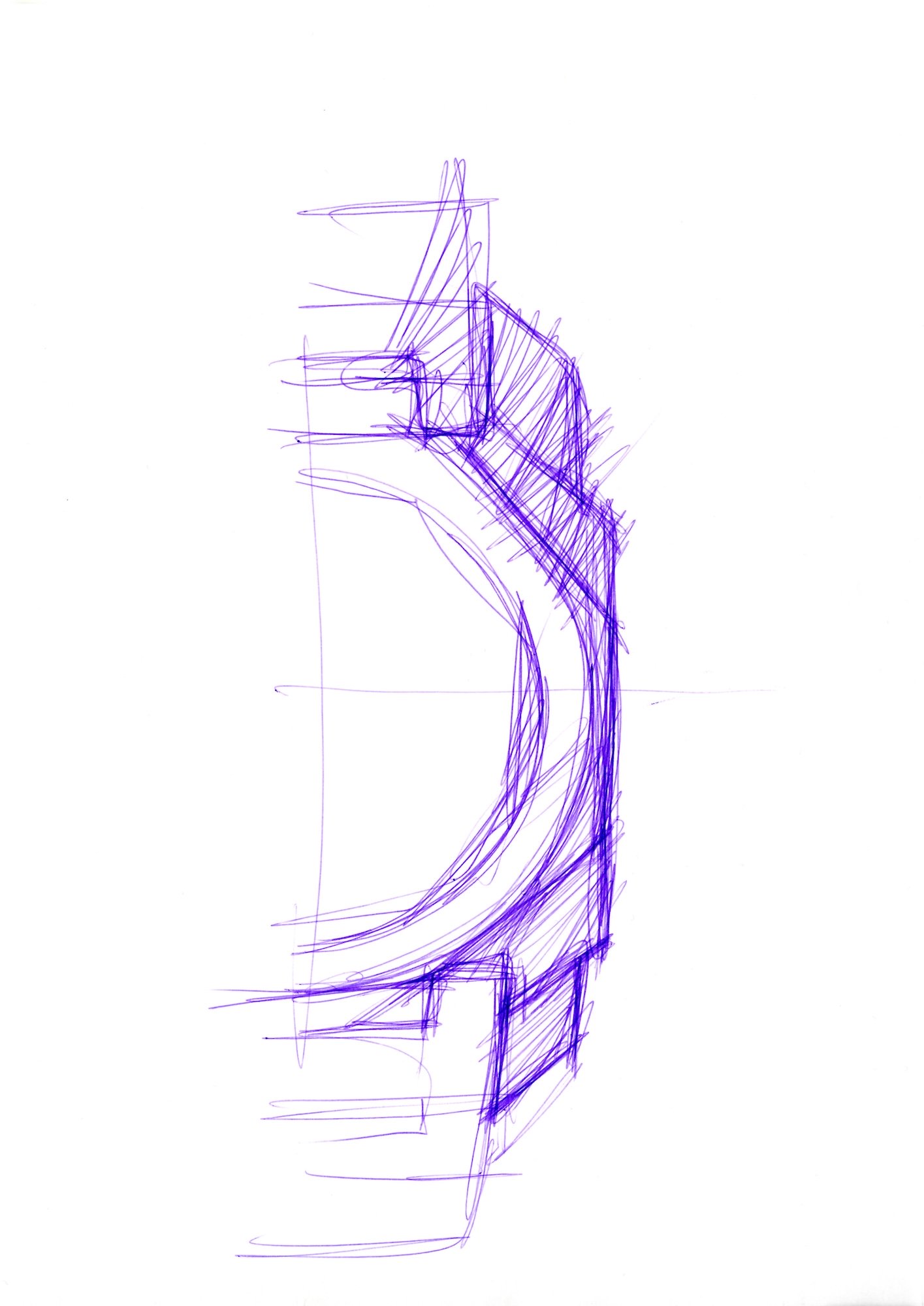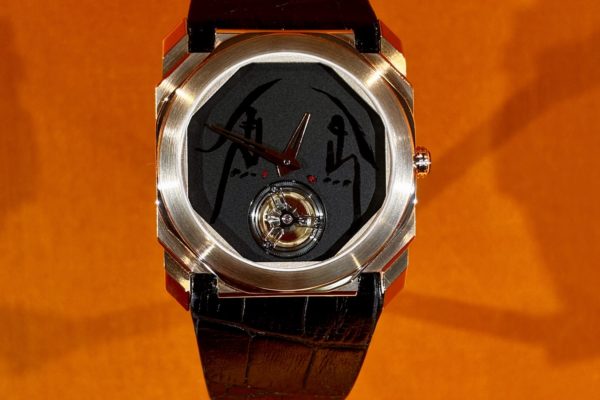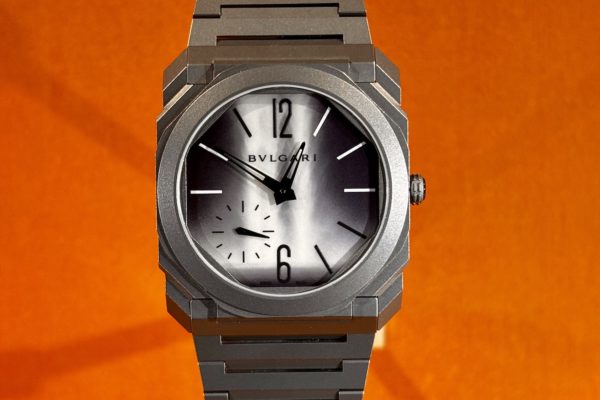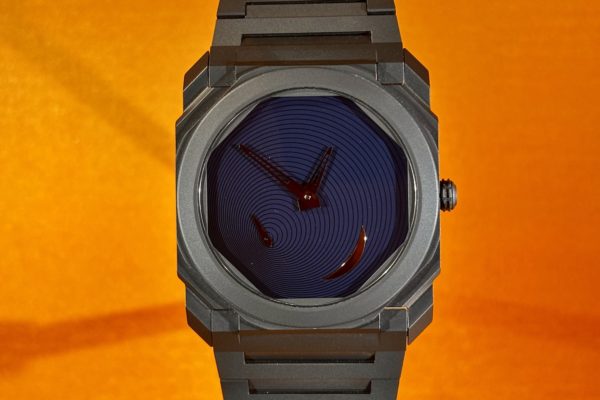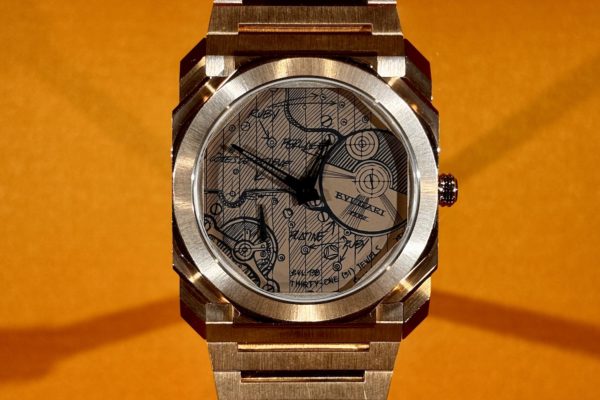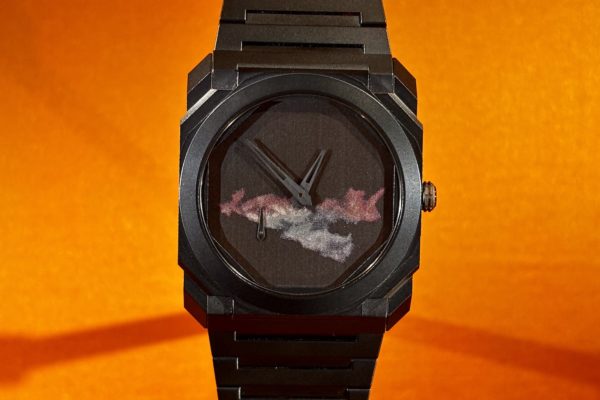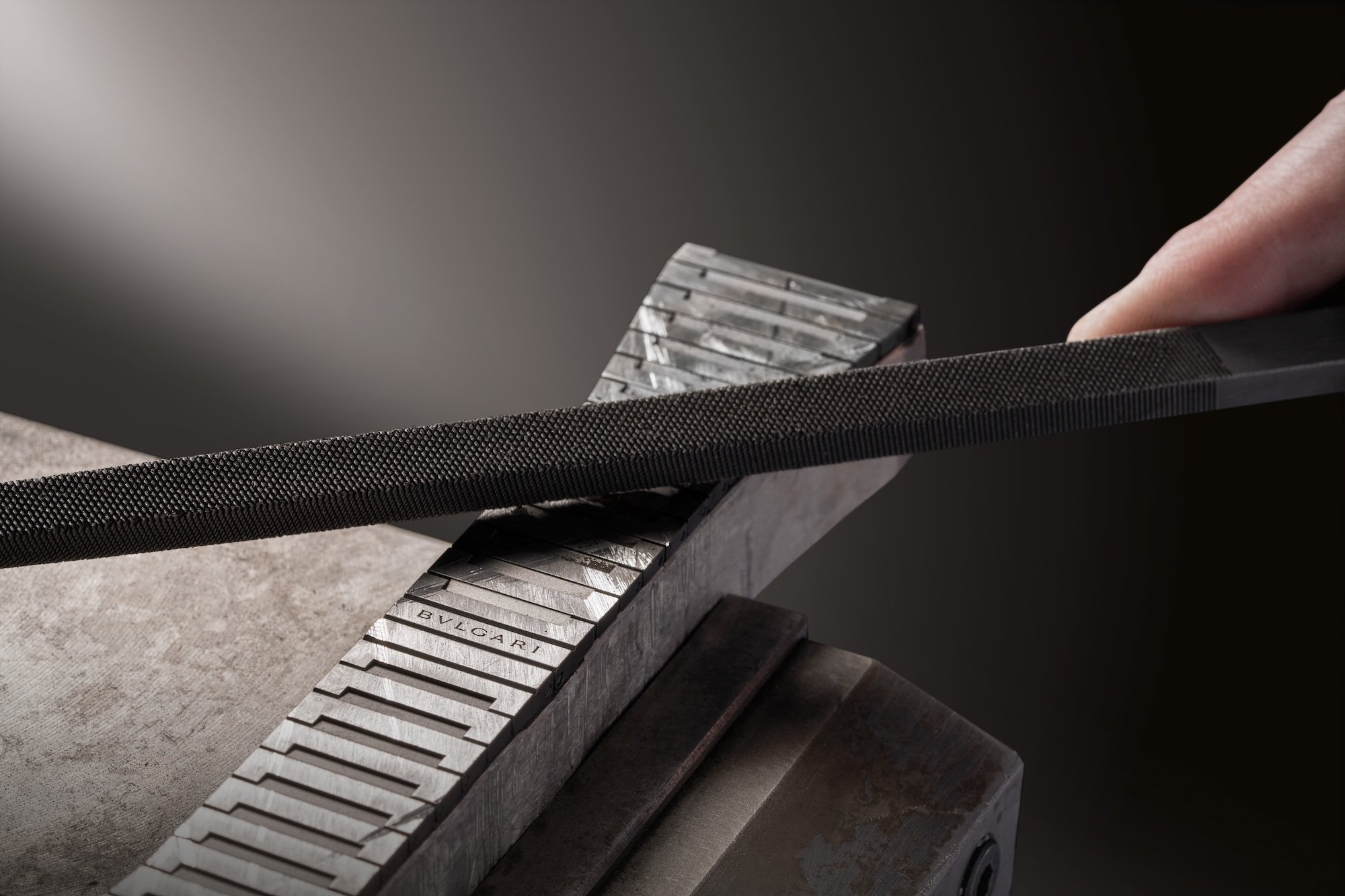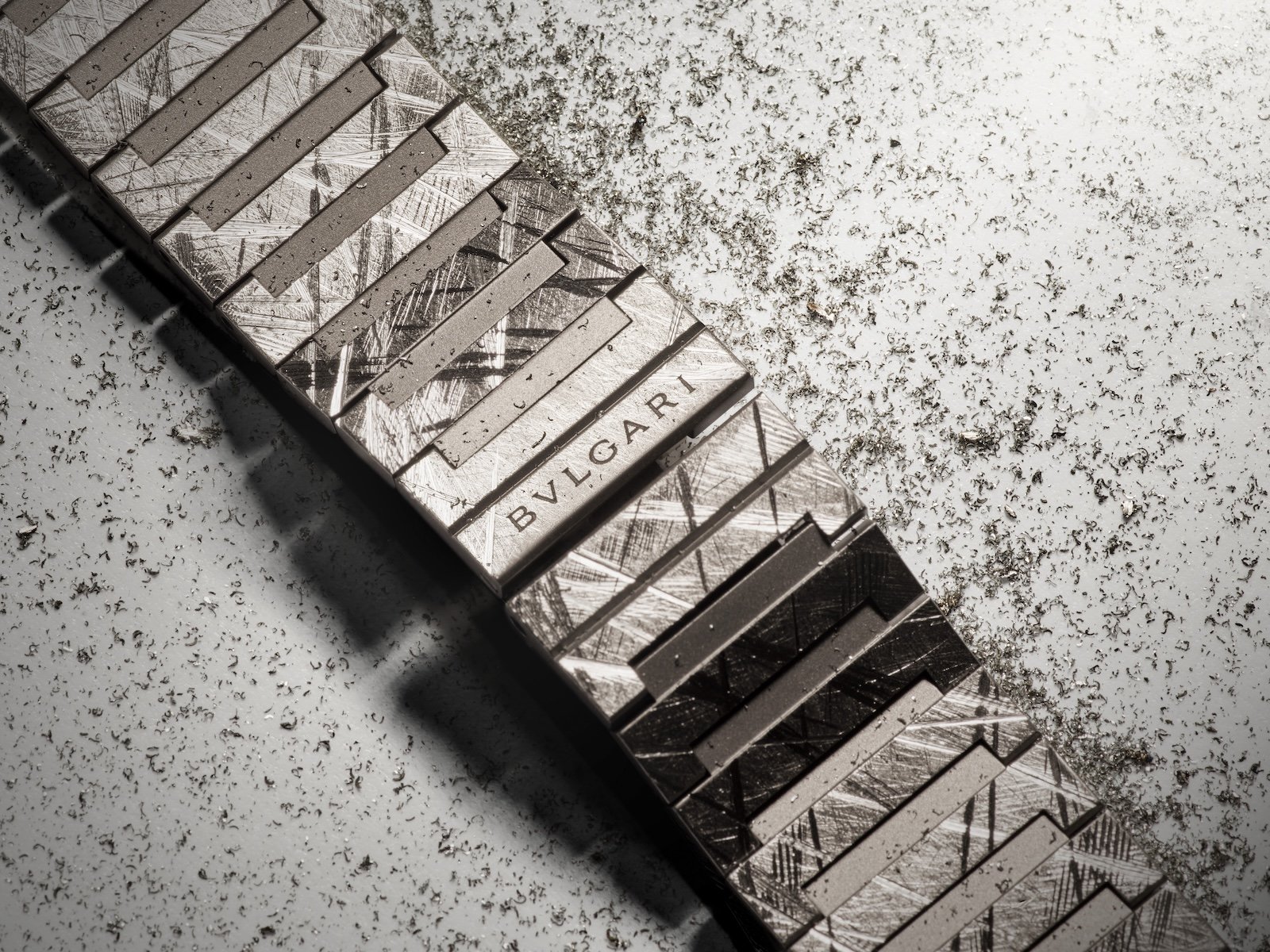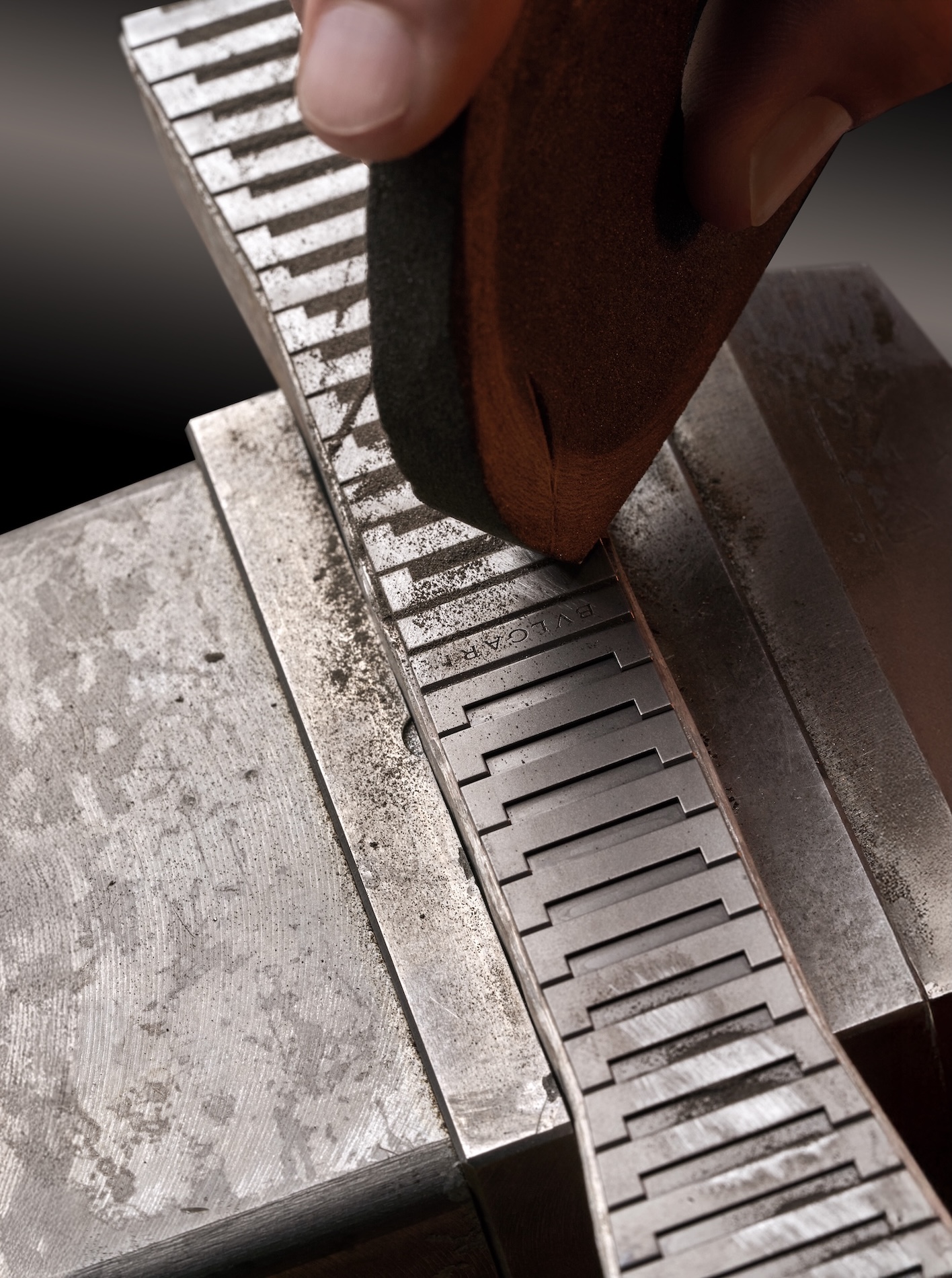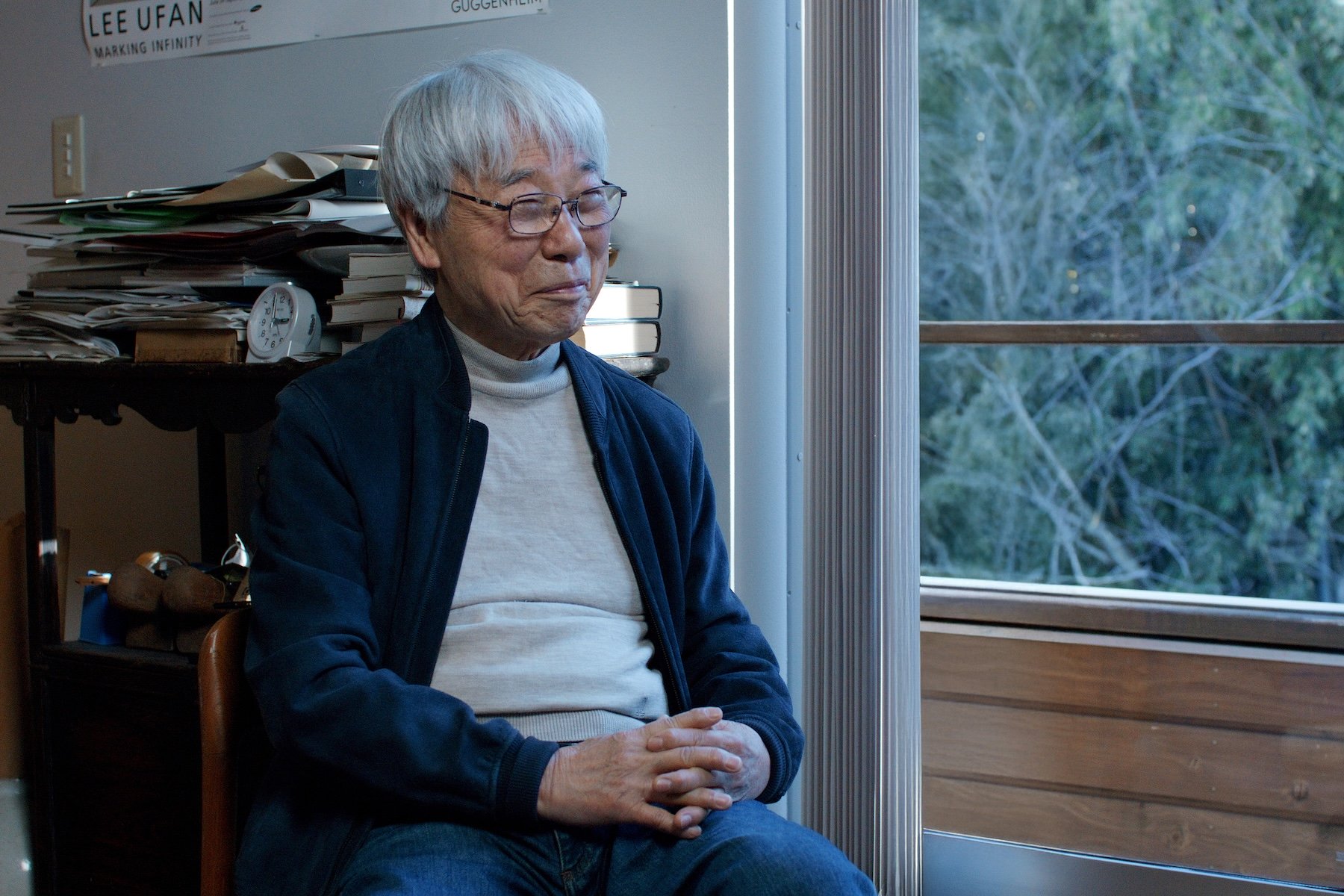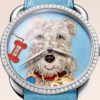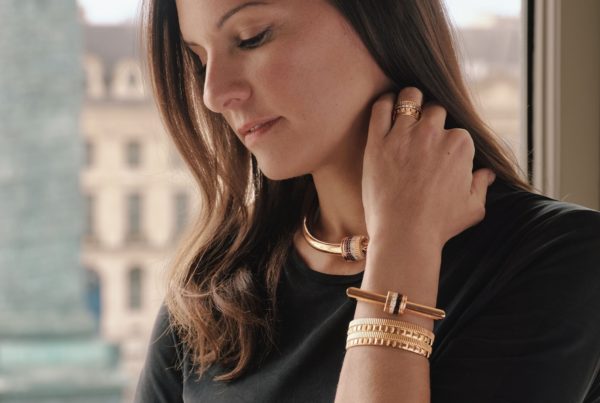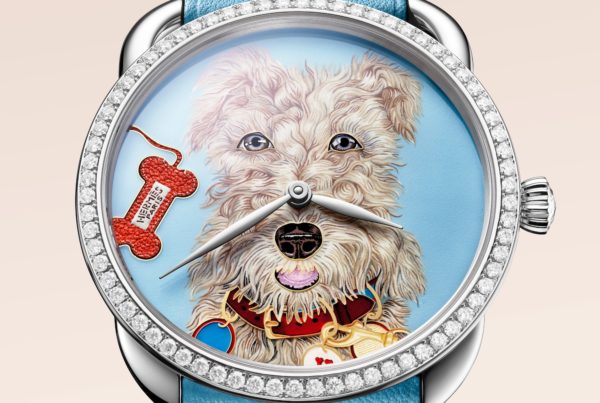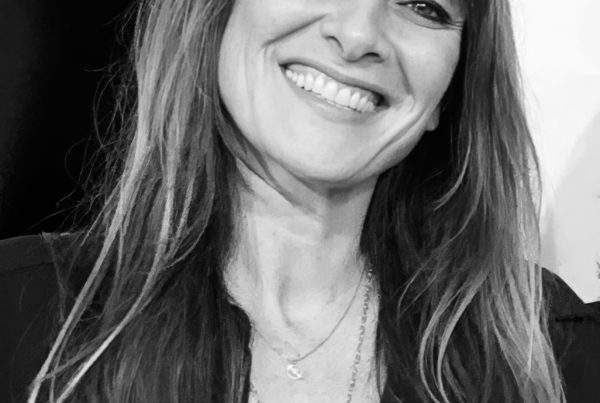Lee Ufan X Bvlgari, the time of minimalism
When the radical minimalism of Korean artist Lee Ufan meets the rich creative universe of Bvlgari, the result is a watch where luxury and asceticism exist in delicate balance. The outcome? The Octo Finissimo Lee Ufan X Bvlgari, unveiled at Geneva Watch Days in early September. During a conversation with Fabrizio Buonamassa Stigliani, Executive Director of Watchmaking Creation at Bvlgari and initiator of the project, we discussed watchmaking, philosophy, art… and the beauty that saves.
It was one of the most eagerly awaited collaborations of the 2025 edition of Geneva Watch Days, held in early September: the Octo Finissimo Lee Ufan X Bvlgari. The Korean artist, who is one of the founders of the minimalist Mono-ha movement, was invited to enter the world of Bvlgari watchmaking and engage in a unique dialogue about the essence of time.
The Octo Finissimo model served as the blank canvas for this artistic co-creation, of which only 150 pieces will be produced. The watch born of this collaboration, both refined and contrasting, is closer to a manifesto than an ornament. It is already a victim of its own success: the Geneva boutique, for example, is facing demand that exceeds supply.
Who better than Fabrizio Buonamassa Stigliani, Executive Director of Watchmaking Creation at Bvlgari, who was behind this model, to talk about it?
Octo Finissimo Lee Ufan X Bvlgari ©Bvlgari 2025
INTERVIEW
The fact that Lee Ufan, renowned for his minimalist approach, has collaborated with Bvlgari to create a watch may be perceived as somewhat paradoxical. What are your thoughts on this?
Fabrizio Buonamassa Stigliani: It all depends on how you approach things. The Octo is a minimalist object because it is powered by an ultra-thin movement. Without a minimalist approach in its execution, it would be impossible to achieve such a result, because certain components have to perform several functions at once. So it made sense to create an Octo based on Lee Ufan’s vision.
The Lee Ufan X Bvlgari Octo Finissimo in side view: a minimalist watch in essence ©Bvlgari
What made you want to work with this artist?
It’s a matter of opportunity. The Bvlgari team in Japan has an incredible network and often offers me collaborations with famous people. Sometimes I say yes, sometimes no. It all depends on the artist’s state of mind. There have been times when we’ve organised meetings and nothing has come of it, because we couldn’t find common ground, because our tastes were too different, or because the artists wanted designs that made no sense from a watchmaking perspective or had nothing to do with the brand. And then, from time to time, a project has an experimental, avant-garde aspect to it, which is exactly what we’re looking for. That’s what the Octo Finissimo is all about: to create it, we had to break the rules and change the standard way of making watches.
Where did you meet Lee Ufan?
He suggested we meet at his home, in his studio. He is a very kind man. He arrived with some ideas already in mind. But in general, initial discussions with artists are always tricky because I often have to say ‘no’. I’ve sat across from Tadao Ando, Sejima, Lee Ufan and I’ve had to say no to them several times. The first time is fine, but by the third time, the artist starts to wonder what we’re doing together.
Lee Ufan and Fabrizio Buonamassa Stigliani in the artist’s studio. ©Bvlgari
Why did you reject Lee Ufan’s initial idea?
Because his proposal was not consistent with the world of watchmaking. It would undoubtedly have made an interesting piece for art collectors, but not for us. We cannot sum up an artist’s entire artistry in a small-scale object such as a watch. It’s too complex, almost impossible.
How did you come up with a joint project?
I began to ask him questions, to try to get him to explain his art, what he had in mind, why a particular element was designed in a certain way and not another. As the discussion progressed, new avenues opened up until we arrived at something truly interesting.
The Octo is a blank canvas: its profile is highly recognisable, but with the rest, an artist can do whatever they want.
There is a link between this watch and Lee Ufan’s Relatum work. How do you take an imposing work made of large stones and broken mirrors and integrate it into a small object that is 40 mm in diameter?
In his garden, I discovered reproductions of many of his works of art. Lee Ufan uses his garden as a small-scale model of the exhibitions he presents around the world. I found this fascinating. Later, in his studio, surrounded by his creations and objects that speak of him, he explained his thinking, his vision, his conception of time. And as he spoke, an idea began to take shape. I took a piece of paper and a pen, made a sketch and asked him if he liked it. He smiled, said yes, and even kept the drawing (laughs). From that moment on, our collaboration truly began.
The original sketch by Fabrizio Buonamassa Stigliani for the Octo Finissimo Lee Ufan X Bvlgari ©Bvlgari
What did your sketch represent?
Lee Ufan had started with a completely different idea, focused on contrasts, but his proposal didn’t really reflect his art. It’s difficult for an artist to design an object that expresses their universe. Often, they will seek to do something completely new, far removed from what they have already done. However, our intention was to create a watch that had never been seen before, but where the artist’s touch was recognisable. So I started with the idea of a polished dial with a case and bracelet with a completely striated surface, like the stones in his works.
Do you always accompany artists in this process?
Yes, we have to help them: they don’t know how to make watches. Lee Ufan talks a lot about philosophical concepts, but my role is to make it all very concrete.
An artist, by definition, is free, but the Octo is an object with a defined format. How did you manage to reconcile the freedom of one with the limitations of the other?
That’s the question! It’s difficult for an artist to determine what is feasible or not on an object that he has not created himself. Lee is a very pleasant person, but we had to change the piece a few months before its launch because he did not agree with the bezel. Initially, it was striated like the bracelet, but he felt it was a bit too much. He wanted a neutral space between the dial, the case and the bracelet to enhance the contrast. In this case, we couldn’t say no because it was the artist’s aesthetic choice. We agreed on the concept and granted his request. For us, it didn’t change anything. Sometimes you have to be willing to compromise in order to achieve a result that suits all parties: the artist, us and the brand, while still making sense.
This isn’t the first time an artist has worked on the Octo fnissimo.
No. In the past, we have experimented with different finishes, different materials and different artists. Some wanted to work on the dial, others on the entire object. The Octo is a bit like a blank page: its profile is highly recognisable, but with the rest, an artist can do whatever they want.
How long does it take to complete a project like this?
Two years. But it all depends on the artist’s ideas and availability. We have worked on a project for two years and, in the end, the artist didn’t like the result. In cases like this, the collaboration is abandoned. You only see the ones that are seen through to completion.
When I returned to Neuchâtel, I asked for a bracelet, went to Jumbo, bought some files and started changing the surface of the links.
How did you make the prototype for the bracelet?
When I got back to Neuchâtel, I asked for a bracelet, went to Jumbo, bought some files and started modifying the surface of the links. My desk was covered in titanium powder! (Laughs). Then I went to the development office and told them we were going to apply this treatment to the bracelets for this model. They were a bit shocked: to them, I had destroyed a perfect bracelet. I replied that we weren’t destroying anything, we were simply changing the finish.
The bracelet of the Octo Finissimo Lee Ufan X Bvlgari has been filed and damaged to evoke the broken stones and mirrors of Lee Ufan’s works. ©Bvlgari
Who made the bracelets for the 150 models?
We found two craftsmen capable of treating the bracelets for the 150 pieces. Honestly, it wasn’t easy for the craftsmen to take bracelets that were ready to be sold and change their appearance and shape to such an extent.
All the bracelets were made by hand, so they are all different.
Yes. And not just the bracelets: the dials too. They are mirror-polished dials sprayed by hand with black paint. Each gradient is therefore different. Lee wanted the upper part to be transparent. We can’t argue with that choice. It’s a matter of feeling, it’s not something tangible. You either like it… or you don’t.
As all the bracelets have been handmade, they are all unique. ©Bvlgari
It’s a question that sometimes arises when looking at a work of art: to like or not to like?
Indeed, but an artist doesn’t have to wonder whether their art is to someone’s taste: what they do is express their point of view. I, on the other hand, create watches that I have to sell to people who will enjoy wearing them on their wrists. Because I have to produce objects, I face technical constraints that an artist does not have.
Is this the first time that the Bvlgari name does not appear on a dial?
No. On all the dials we created with great artists and architects, we removed the brand name. The first time was with Tadao Ando: he first created a design, then added all the indexes and the logo. He did everything perfectly! We decided to remove everything: the logos, the digits, everything! We didn’t need it. It was his dial. The story was magnificent. Everyone knows the Octo. We didn’t need a logo.
Do you consider this watch to be a utilitarian object or a work of art?
For me, it’s already a mechanical work of art. Then, with this hand-crafted finish, it speaks of Lee Ufan’s art, of a different conception of time.
The Octo Finissimo Lee Ufan X Bvlgari speaks of Lee Ufan’s art, of a different conception of time.
This ultra-minimalist model is closer to a manifesto than an ornament. Was that your intention?
Yes, I did it on purpose because before Lee Ufan, we worked with Sejima, with whom we created the invisible watch, which was completely polished and super elegant. With Lee Ufan, we created a watch with lots of contrast. We want to offer a different story each time. We go beyond simply changing the dial or the colours. An Octo is more about spirit than aesthetics.
Meaning?
We don’t have to make a strictly octagonal shape for a watch to be recognised as an Octo. The Octo Finissimo Ultra, for example, is no longer really an Octo: it’s a square watch with a barrel that cuts across the shape of the dial, and the bezel isn’t round. The essence of the Octo is its iconic bracelet with a watch shape that is more or less octagonal. I would like to make a special edition where the dial is also hidden.
Would that be your ultimate dream with the Octo: to hide the dial?
As a collector, I don’t need to read the time on my Octo: I have a phone and 50 watches at home. With the Octo, I am buying an object that is the expression of a brand with incredible watchmaking expertise. You can recognise the signs. It’s like the Porsche 911: you look at the first one, you look at the latest one, there’s nothing in common between the two, but it’s the same car because the spirit is the same, the lines are the same. If I draw a line like this (he draws half the silhouette of an Octo on a piece of paper, editor’s note), everyone knows it’s an Octo. Today, I no longer need to draw it in its entirety: half is enough to identify it. We have it in our heads. Once this model has become standardised, it means that we can put whatever we want inside it.
Is this watch aimed at art collectors, watch enthusiasts, or both?
Honestly, Octo collectors can be found everywhere. Some are true watch enthusiasts and love the Ultra, while others are young collectors who appreciate the steel Octo for its finesse and wearability in their everyday professional lives. There are also people who had never bought a Bvlgari watch before and were seduced by the Sejima, simply because it is such a fantastic piece. This watch is like a chameleon: by changing the dial or the finishes, it transforms completely.
For the model co-created with Lee Ufan, did you choose this finish to reflect the effect of the broken mirrors in his works?
Yes. What’s interesting to note are the small intermediate links: they are made of sandblasted titanium because we couldn’t damage them, but I really like this finish because the material changes colour when treated in this way. It’s more shiny.
The intermediate links of the bracelet are made of sandblasted titanium. This finish changes the colour of the material. ©Bvlgari
Do you think this watch could have an influence on the wearer and encourage them to reflect on time?
Honestly, I don’t know. But it’s clear that someone who buys a watch like this has a certain sensibility. Some customers will buy it for their collection, others to wear it, and a few to keep it in a safe. You never know what’s going on in people’s minds. Some of our customers are passionate about art, others about watch mechanics, and there are also buyers who are fascinated by design. It’s interesting to have this different perspective compared to other watch brands. The models created by Sejima and Lee Ufan are philosophical concepts first and foremost, before being watches. The watch is merely a vehicle for talking about something else. Yesterday, a major collector told me that this model was a real talking point, a watch that sparks conversation and discussion about a thousand details. He is a fan of the Octo, but had never bought one because he hadn’t yet found the perfect one for him. He treated himself to this one.
In what silence does this watch speak to you?
This watch reminds me of an experience I had with Lee Ufan. I was in his studio, surrounded by his objects and books. We were just together. We met in Tokyo, Kamakura, Paris, and discussed watches, wine, Italy, a thousand different subjects.
Lee Ufan dans son atelier ©Bvlgari
Do you feel that this watch embodies Lee Ufan’s philosophy of time?
No, it’s not possible to put all that into a watch. It’s one of Lee Ufan’s many artistic expressions. He’s an 89-year-old artist. The art we see is his whole life. I don’t know if I can explain Lee Ufan’s entire life through a watch with a diameter of 40 millimetres. We make watches. It’s an object. We shouldn’t give it too much meaning. We buy it because we like the mechanics, because it’s an expression of our own taste. This model allows us to explain our own universe to others. It’s just a watch, we don’t need it to live and it doesn’t change people’s lives.
Beauty does not depend on form but on the strength of intention behind the gesture.
No, but it’s a beautiful object.
Yes, and beauty is something that helps, especially today when it’s so rare! As a designer, I believe that beauty can save us. We don’t always understand the importance of a beautiful object or a failed object in our lives, and yet when we use something that has been poorly designed, we feel it immediately. The same goes for a beautiful object: we don’t know why, but we love using it.
Is it because of the harmony it creates?
A beautiful object evokes very different emotions. Beauty does not depend on form but on the strength of the intention behind it. In Italy, we say that something that is poorly made was not made with love, that it was not made by someone who had you in mind. Beauty lies in this small detail: intention. It is not simply ‘bellezza’, it is a philosophical concept. For Italians, beauty is a croissant when you wake up, a view of Venice, a song by Pavarotti, an exceptional pizza. Beauty is a tangible experience: we love to touch it, taste it, listen to it, see it. It is everywhere: in Puccini, Verdi, Venice, homemade pasta made by an old lady who has carefully kneaded the dough and shaped the fettuccine. It is a whole process. Beauty comes from expertise. If you don’t have the expertise, you can’t create beauty. That’s why some watches are expensive. Sorry, but two centuries of expertise are priceless!

